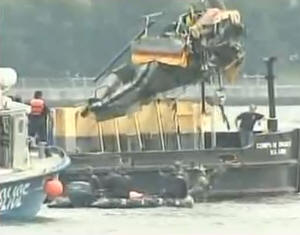
 |
NEWSROOM |
|
|
|
||||
|
FAA Announces Plan to Enhance Safety for New York Airspace By Mike Mitchell (update) |
||||
 |
September 7, 2009: On Saturday, August 8, 2009, just before noon a Piper Lance aircraft, PA-32R-300 collided in midair into the rear of a sightseeing helicopter over the Hudson River in New York City (See 9 Killed In Airplane Helicopter Midair Collision Over The Hudson).As a result the Federal Aviation Administration (FAA) is planning to modify the airspace over the Hudson River by revising procedures to create safe, dedicated operating corridors for all the aircraft that fly at lower altitudes around Manhattan.“The New York Airspace Task Force chartered on August 14 developed a comprehensive series of recommendations that we plan to implement as quickly as possible,” said FAA Administrator Randy Babbitt. “These steps will significantly enhance safety in this busy area and create crystal-clear rules for all of the pilots who operate there.” |
|||
|
The safety enhancements would restructure the airspace, mandate pilot operating rules, create a new entry point into the Hudson River airspace from Teterboro, standardize New York area charts and develop new training for pilots, air traffic controllers and businesses that operate helicopters and aircraft in the area. One of the most significant changes, if adopted, would divide the airspace into altitude corridors that separate aircraft flying over the river from those operating to and from local heliports or seaplane bases. Specifically, this new exclusionary zone would be comprised of three components:
|
||||
|
New pilot operating practices would require pilots to use specific radio frequencies for the Hudson River and the East River, would set speeds at 140 knots or less, and would require pilots to turn on anti-collision devices, position or navigation equipment and landing lights. They would also require pilots to announce when they enter the area and to report their aircraft description, location, direction and altitude. Existing common practices that take pilots along the west shore of the river when they are southbound and along the east shore when they are northbound would become mandatory. In addition, pilots would be required to have charts available and to be familiar with the airspace rules. The FAA also intends to propose standardized procedures for fixed-wing aircraft leaving Teterboro to enter the Class B airspace over the Hudson River or the exclusionary zone. If an aircraft plans to enter the Class B airspace, Teterboro controllers would request approval from Newark before the aircraft takes off and be authorized to climb the aircraft to 1,500 feet. Aircraft that want to enter the VFR exclusionary zone would be directed by a special route over the George Washington Bridge. The FAA expects to complete and publish any changes in time to have them in effect by November 19, so that they can be incorporated on new, standardized aeronautical charts that will replace existing charts. The charts will highlight the Class B VFR corridor, encouraging more pilots to exercise the option to fly over the Hudson River under air traffic control, instead of entering the congested exclusionary zone. Finally, the FAA intends to develop training programs specifically tailored for pilots, air traffic controllers and fixed-base operators to increase awareness of the options available in the Hudson River airspace, and better develop plans that enhance safety for the intended flight. “We have reinforced how important it is to follow the recommended procedures and maintain professional conduct until we put the new mandatory measures in place,’’ said Administrator Babbitt. “These new safety steps incorporate the collective experience of pilots who fly in that airspace as well as our own air traffic controllers and the National Air Traffic Controllers Association. We all want the skies over New York to be as safe as they can be.” The FAA chartered the New York Airspace Task Force on August 14 and proposed actions based on the group's August 28 report. The National Transportation Safety Board (NTSB) issued independent recommendations on August 27 that were not used in the development of the task force's safety enhancements. The FAA's proposed actions meet or exceed the NTSB's recommendations. |
| ©AvStop Online Magazine Contact Us Return To News |